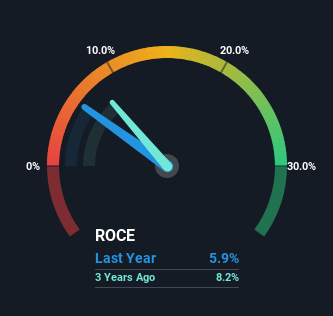Here's What To Make Of Northland Power's (TSE:NPI) Decelerating Rates Of Return
If we want to find a potential multi-bagger, often there are underlying trends that can provide clues. One common approach is to try and find a company with returns on capital employed (ROCE) that are increasing, in conjunction with a growing amount of capital employed. If you see this, it typically means it's a company with a great business model and plenty of profitable reinvestment opportunities. Having said that, from a first glance at Northland Power (TSE:NPI) we aren't jumping out of our chairs at how returns are trending, but let's have a deeper look.
What Is Return On Capital Employed (ROCE)?
For those who don't know, ROCE is a measure of a company's yearly pre-tax profit (its return), relative to the capital employed in the business. To calculate this metric for Northland Power, this is the formula:
Return on Capital Employed = Earnings Before Interest and Tax (EBIT) ÷ (Total Assets - Current Liabilities)
0.059 = CA$731m ÷ (CA$14b - CA$1.3b) (Based on the trailing twelve months to December 2023).
Therefore, Northland Power has an ROCE of 5.9%. In absolute terms, that's a low return but it's around the Renewable Energy industry average of 5.0%.
See our latest analysis for Northland Power

Above you can see how the current ROCE for Northland Power compares to its prior returns on capital, but there's only so much you can tell from the past. If you'd like, you can check out the forecasts from the analysts covering Northland Power for free.
What The Trend Of ROCE Can Tell Us
The returns on capital haven't changed much for Northland Power in recent years. The company has employed 29% more capital in the last five years, and the returns on that capital have remained stable at 5.9%. Given the company has increased the amount of capital employed, it appears the investments that have been made simply don't provide a high return on capital.
The Bottom Line
In summary, Northland Power has simply been reinvesting capital and generating the same low rate of return as before. And with the stock having returned a mere 17% in the last five years to shareholders, you could argue that they're aware of these lackluster trends. As a result, if you're hunting for a multi-bagger, we think you'd have more luck elsewhere.
One final note, you should learn about the 2 warning signs we've spotted with Northland Power (including 1 which is a bit concerning) .
While Northland Power may not currently earn the highest returns, we've compiled a list of companies that currently earn more than 25% return on equity. Check out this free list here.
Have feedback on this article? Concerned about the content? Get in touch with us directly. Alternatively, email editorial-team (at) simplywallst.com.
This article by Simply Wall St is general in nature. We provide commentary based on historical data and analyst forecasts only using an unbiased methodology and our articles are not intended to be financial advice. It does not constitute a recommendation to buy or sell any stock, and does not take account of your objectives, or your financial situation. We aim to bring you long-term focused analysis driven by fundamental data. Note that our analysis may not factor in the latest price-sensitive company announcements or qualitative material. Simply Wall St has no position in any stocks mentioned.